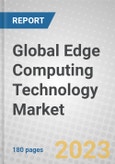This report studies the global as well as regional markets for edge computing technologies, identifying newer markets and exploring the expansion of the current application market for various end-users. A realistic five-year forecast has been made for the future global markets for different types of components in edge computing. The end uses for edge computing are discussed to establish global as well as regional usage. A future forecast has been made for all end-user industries.
In this report, the edge computing market has been segmented based on component, industry, and geography. The report provides an overview of the global edge computing market and analyzes market trends. Using 2021 as the base year, the report provides estimated market data for the forecast period 2022 through 2027. Revenue forecasts for this period are segmented based on component, industry, and geography. In addition, the report also offers a major regional analysis of North America, Europe, Asia-Pacific, Latin America, the Middle East, and Africa. The estimated and forecast market revenue considered in this report is the summation of prices for software, hardware, and subscription services.
COVID-19 has had a massive impact on society since the start of 2020. This report considers the impact of COVID-19 and the economic slowdown it created. With people relying more on technology, the demand for edge computing will increase and boost market growth. The report also focuses on the major trends and challenges that affect the market and the vendor landscape.
This report has been prepared in a simple easy-to-understand format, with several tables and charts/figures. The scope of the report includes a detailed study of global and regional markets for edge computing, with reasons given for variations in the growth of the industry in certain regions. The report examines each component of edge computing technology, determines its current market size, and estimates its future market. The report also analyzes the market from the manufacturers’ viewpoint as well as that of the final consumer. Several technical issues arising out of the utilization of edge computing technologies are discussed, and solutions are indicated.
Report Includes
- 40 data tables and 34 additional tables
- An updated overview and in-depth analysis of the global markets for edge computing technologies
- Analyses of the global market trends, with historical market revenue data (sales figures) for 2021, estimates for 2022, forecasts for 2023, and projections of compound annual growth rates (CAGRs) through 2027
- Discussion of industry growth driving factors and major technology issues and challenges affecting the market for edge computing technologies as a basis for projecting demand in the next few years (2022-2027)
- Estimation of the actual market size and revenue forecast for global edge computing market, and corresponding market share analysis by business segment, provider type, end-use industry, and region
- Updated information on recent market dynamics, industry shifts and regulations, and the impact of Covid-19 and other macroeconomic variables that will influence this market over the analysis period
- Analysis of market opportunities with a holistic review of Porter’s five forces analysis and value chain analysis considering both micro
- and macro environmental factors prevailing in the market
- Review of key granted patents and patents published on edge computing technologies by Mar 2023
- A look at the major growth strategies adopted by leading players operating in the edge computing industry, along with their recent developments, strategic alliances, and competitive benchmarking
- Identification of the major stakeholders and analysis of the competitive landscape based on recent developments and segmental revenues
- Descriptive company profiles of the leading global players, including Amazon Web Services (AWS), Microsoft Corp., Google (Alphabet Inc.), Cisco Systems Inc., Dell Technologies Inc., and VMware Inc.
Table of Contents
Companies Mentioned
- Key Players
- Alphabet Inc.
- Amazon.Com Inc.
- Barracuda Networks Inc.
- Capgemini Se
- Check Point Software Technologies Ltd.
- Cisco Systems, Inc.
- Dell Technologies Inc.
- Edgeiq
- Ekinops Sa
- Fortinet Inc.
- Fujitsu Ltd.
- General Electric Co.
- Hewlett Packard Enterprise Co.
- Honeywell International Inc.
- Huawei Technologies Co. Ltd.
- International Business Machines Corp.
- Intel Corp.
- Juniper Networks Inc.
- Litmus Automation
- Microsoft Corp.
- Oracle Corp.
- Rockwell Automation Inc.
- Sap Se
- Siemens AG
- Vmware Inc.
- Western Digital Corp.
- Emerging Start-Ups in the Edge Computing Industry
Table Information
| Report Attribute | Details |
|---|---|
| No. of Pages | 180 |
| Published | May 2023 |
| Forecast Period | 2022 - 2027 |
| Estimated Market Value ( USD | $ 46.3 Billion |
| Forecasted Market Value ( USD | $ 124.7 Billion |
| Compound Annual Growth Rate | 21.9% |
| Regions Covered | Global |
| No. of Companies Mentioned | 28 |









